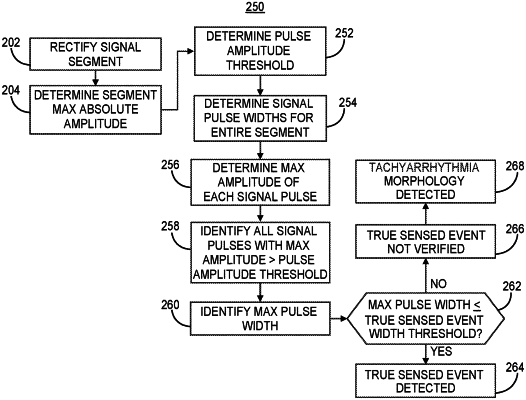| CPC A61N 1/3621 (2013.01) [A61B 5/352 (2021.01); A61B 5/363 (2021.01); A61N 1/365 (2013.01); A61N 1/3704 (2013.01); A61N 1/3706 (2013.01)] | 29 Claims |

|
1. A medical device comprising:
a cardiac electrical signal sensing circuit configured to:
sense at least one cardiac electrical signal;
detect cardiac events from the at least one cardiac electrical signal;
a control circuit configured to detect tachyarrhythmia based on the cardiac events detected from the at least one cardiac electrical signal meeting tachyarrhythmia criteria; and
a therapy delivery circuit configured to generate a therapy in response to the control circuit detecting the tachyarrhythmia;
the control circuit further configured to:
in response to each one of a plurality of cardiac events detected from the at least one cardiac electrical signal, determine a signal feature from a segment of the at least one cardiac electrical signal;
detect an alternating pattern of the signal feature determined from consecutive segments of the at least one cardiac electrical signal;
from each of at least one segment of the consecutive segments of the at least one cardiac electrical signal, determine at least one gross morphology metric by determining one of:
an amplitude metric as the at least one gross morphology metric; or
a maximum signal pulse width metric as the at least one gross morphology metric;
compare the at least one gross morphology metric to tachyarrhythmia morphology criteria;
determine that the at least one gross morphology metric does not meet the tachyarrhythmia morphology criteria;
detect cardiac event oversensing in response to the at least one gross morphology metric not meeting the tachyarrhythmia morphology criteria and detecting the alternating pattern;
withhold a tachyarrhythmia detection in response to detecting the cardiac event oversensing; and
control the therapy delivery circuit to withhold the therapy when the detection of the tachyarrhythmia is withheld.
|